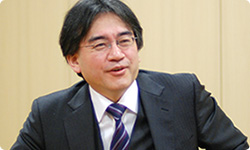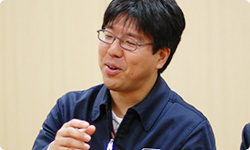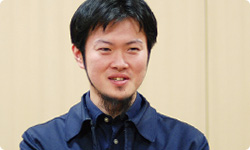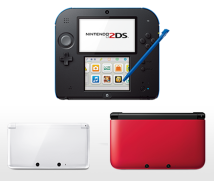4. Laughter with the Merge Effect
One of the camera modes on Nintendo 3DS Camera is the Merge effect8, where you merge your face with the face of someone across from you. What triggered the idea for that? 8 Merge effect: One of the seven types of camera modes on Nintendo 3DS Camera built into the Nintendo 3DS system. By using the inner camera and one of the outer cameras to take a photo of two faces simultaneously, you can shoot a merged photo of the two faces.
Nintendo 3DS Camera was developed in cooperation with INTELLIGENT SYSTEMS CO., LTD.9 First of all, we made prototypes in line with three different themes. For the first theme, having face-recognition capability requires the capacity to pare the image down to just the face. So, we asked them to run experiments on switching faces, or making all faces the same, like the sextuplets in the manga Osomatsu-kun. 9 INTELLIGENT SYSTEMS CO., LTD.: A game developer who has developed Nintendo software, including the Fire Emblem series and the Paper Mario series, and development support tools for successive hardware. Headquartered in Kyoto.
So it started when you were wondering how to apply face-recognition technology.
Yes. Then another theme was to think up a game with a new structure that involved using the inner camera and the outer cameras at the same time, instead of simply taking 3D photos.
Usually, even if a device has both an inner and an outer camera, you can only use one of them at a time. I think being able to use both at once is probably a rare configuration.
Right. Then, the Nintendo DSi system had the Resemblance lens10, where two people could line up and take a photo and have fun communicating, so the third theme was to put in a function that would further promote that sort of communication. 10 Resemblance lens: One of the eleven lenses of Nintendo DSi Camera built into the Nintendo DSi system. By photographing two people standing side by side, you can compare how alike their faces are.
In other words, first you thought of broad themes, then asked INTELLIGENT SYSTEMS to create the bases for them.
That's right. After a little while, we got the prototypes back, and they were exactly what we needed, so we based the current Merge effect on them.
The finished function is such that, when you see the end result, you'll dissolve into laughter then and there; you can't help it.

I think people tend to choose hairstyles and clothes that complement their own face, but with the Merge effect, your face is switched with someone else's - the impression feels off somehow, and it's very funny. (laughs)
When something you're not used to seeing, something off-kilter, is displayed on the screen, you laugh.
Right. When you go to sightseeing spots, sometimes you'll find photo boards in different shapes, like ninjas, you know?
Yes, the sort of sign where you put your face into the hole where the character's face should be and have your photo taken.
It's that basic premise: the other person becomes the sign board, and the merged face goes into the opening. I think it's a bit different from the usual synthesis method.
Normal face synthesis tends to use the eyes from one person, the nose from the other, etcetera, but this is different. The Merge effect may show more of the appearance of the person with the stronger face.
Um… So, when I merge my face with someone else, they end up being another Mizuki’s picture all the time.
You mean, when you shoot yourself with the inner camera, it will be Mizuki-san’s picture, and when you shoot yourself with the outer camera, it will still be Mizuki-san in the final picture? (laughs)
(laughs)
Why is that…?

Because everyone knows your face is strong, Mizuki-san. (laughs)
Still, it's funny the way you can look at photos taken with the Merge effect and think, “You know, I've seen this guy somewhere before…”
Oh yes, I know him. (laughs)
I'm pretty sure I've met this guy somewhere. (laughs)
Lots of times, with merged photos, the face you end up with couldn't possibly belong to anyone. By the way, if there's anything you plan to do with cameras in future, could you talk about them now, do you think?
Sure… But, Iwata-san, you've already… (laughs)
Ah! Did I already say it? (laughs)
When I read the first Nintendo 3DS interviews in Iwata Asks, titled “And That's How the Nintendo 3DS Was Made,” you'd already talked about Iwata Asks: Nintendo 3DS and I thought, "Oh hey, the specs are written here…" (laughs) For example, an SD Card needs to be able to save lots of them. But now that we're actually able to shoot 3D images, it's really fun, and the large memory capacity on the SD Card will really come in handy.
In other words, look forward to future model upgrades.
Right. We're currently working diligently to produce them.
Just glancing at Nintendo 3DS Sound, which you were involved with, Akifusa-san, it's hard to tell how it's different from the Nintendo DSi system. There are several differences, though, aren't there?
Yes. First, this time, it was a project about using StreetPass, and if you register what sort of song you're listening to, you can trade song and artist names with other people.
So you'd register that in the Nintendo 3DS Sound StreetPass playlist, then.
That's right. We tried to make it so that you'd be able to tell if a person you have StreetPass with happened to be listening to the same song you were listening to, or what sort of songs were popular among the people around you. Those were challenges we set for ourselves and wrestled with.
That's why you want people to register songs on the StreetPass playlist, once they're on their SD Cards, and walk around with the Nintendo 3DS system.
Yes. I think the results will differ by neighbourhood, too. The songs that are popular when you're walking around Shibuya may be different from the ones that are popular when you're walking around Akihabara. So, personally, I think I'd like to try walking around different neighbourhoods and have StreetPass with people. Also, and this is about the internal system now, but you can listen to mp3 files on the Nintendo 3DS system; they weren't supported on the Nintendo DSi system. We've also put in a function that lets you start listening to a song from the place where you left off.

Because listening from where you left off is a perfectly normal function in regular music players.
We implemented it this time. Then, we also made it so that you can record audio data and save it to the SD Card for later.
It's a bit of a recorder, then, too.
Yes. Since they're saved to the SD Card, the number of sounds you can record has increased. I think people who are good with computers can probably use them as normal sound data as well.
In that sense, it's become more versatile as sound software, and has turned into something that people can use more often.
Right. As you said yourself, Iwata-san, it's hard to tell just by looking at it, but we've done quite a bit internally. I think the basic usability of the software has improved, compared to what it was on the Nintendo DSi system. We've also reviewed the content of Music Visualiser that's displayed on the upper screen, so I'd be glad if people had fun with that.
